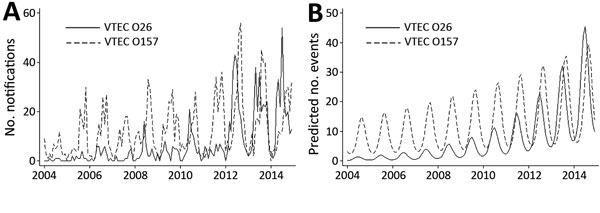Volume 22, Number 4—April 2016
Letter
Serogroup-specific Seasonality of Verotoxigenic Escherichia coli, Ireland
Figure

Figure. Verotoxigenic Escherichia coli (VTEC) O157 and VTEC O26, Ireland, 2004–2014. A) Seasonal distribution of notifications. B) Predicted seasonal distribution. Data source: Computerised Infectious Disease Reporting System (https://www.hpsc.ie/NotifiableDiseases) in Ireland, as of June 24, 2015. Predicted number of cases by month were derived from a cyclical quasi-Poisson model after trend and seasonality and interaction by serogroup were accounted for.
Page created: March 16, 2016
Page updated: March 16, 2016
Page reviewed: March 16, 2016
The conclusions, findings, and opinions expressed by authors contributing to this journal do not necessarily reflect the official position of the U.S. Department of Health and Human Services, the Public Health Service, the Centers for Disease Control and Prevention, or the authors' affiliated institutions. Use of trade names is for identification only and does not imply endorsement by any of the groups named above.